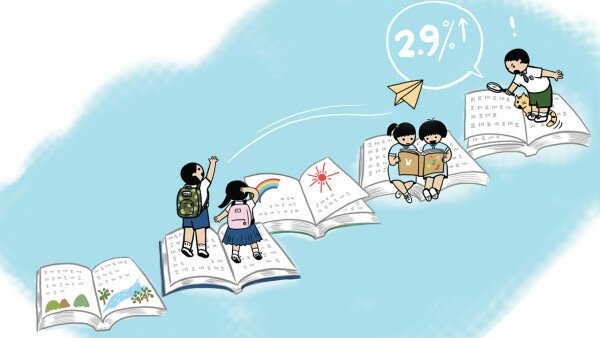Primary and secondary school textbooks prices have been on the rise for consecutive years. The expenditure in purchasing textbooks for new school year has become a financial burden for many families. The Consumer Council's 2016/17 textbook price survey revealed that prices of more than 90% of the sampled textbook have increased by an overall average of 2.9% in the new school year.
The survey covered a total of 678 commonly used textbooks (232 for primary schools and 446 for secondary schools) offered by 24 publishers. Among these textbooks, only 37 (5.5%) have their prices frozen. Prices of the remaining 641 (94.5%) have increased by 0.4% to 6.8%. Furthermore, the survey also showed that none of the sampled textbooks have cut their prices, making this the fourth consecutive year with no price deduction. Most of the textbooks with their prices frozen come from non-major subjects including Religious Education, Music, Putonghua, Home Economics, Chinese Literature, Tourism and Hospitality Studies, etc.
This year, the average price increase for primary and secondary school textbooks is 2.9%. Comparing to last year's 4% and 3.7% in the year before, the overall increase is relatively mild, marginally higher than the 2.6% inflation rate.
When looking by subjects, Religious Education is the only one with no price change among all primary school textbooks. Prices of textbooks for the other subjects have seen an average increase of 2.6% to 4.1%, with music textbooks being the highest one. As for secondary school textbooks, there is no change in price for textbooks of three subjects. Textbook prices of all other subjects have increased by an average of 1.4% to 4.8% with visual arts textbooks recorded the highest increase.
It is worth noting that for the top 10% textbooks with the highest price increase, the adjustment ranging from 4.2% to 6.8% is significantly higher than the inflation rate for the same period. About 95% of them are secondary school textbooks, mostly for Chemistry, Geography, Biology, and Science. If compared to prices in 2014, the accumulated price increase for these textbooks over the past 3 years is nearly 10%.
The Education Bureau has fully implemented the "Policy of Debundling Textbooks and Teaching/Learning Materials for Pricing" since 2014 to avoid bundled sale of textbook, teaching and learning materials, and to enable students and teachers to purchase, according to their own needs, textbooks and teaching materials with prices clearly marked. All textbooks sampled this year have their prices debundled from teaching and learning materials. However, it's noteworthy that whether debundled prices can truly relieve consumers' burden will depend on the rate of price increase of learning materials. A more comprehensive conclusion could only be reached after further observations.
Responding to Council's enquiries, publishers attributed the price increase to their increasing operation costs including rentals, salaries, logistics and printing costs, the drastic decrease in student number and also the reduction of enrolled elective subjects in senior secondary forms. According to data provided by the paper and printing industries, average prices of woodfree paper and art paper have dropped by 2.9% and 3.1% respectively while the average printing cost is more or less the same as that of last year.



